The inspiring Terracotta Army is something to amazed by.
For enthusiasts of ancient China a trip to view the life-sized terracotta army in Xian, is a must see.
Upon arrival, travelers are easily impressed by the numbers and sheer size of these warrior formations. Cast from real life individual soldiers, each one of them is unique. Their purpose was to provide protection for the first Emperor of China, in the afterlife.
Along with the terracotta men of various sizes and shapes there are an impressive collection of chariots and horses as well. All told according to estimates, there are a total more than 8,000 warriors in the terracotta army, 130 chariots with 520 horses and 150 cavalry horses.
These are spread among three different main pits.
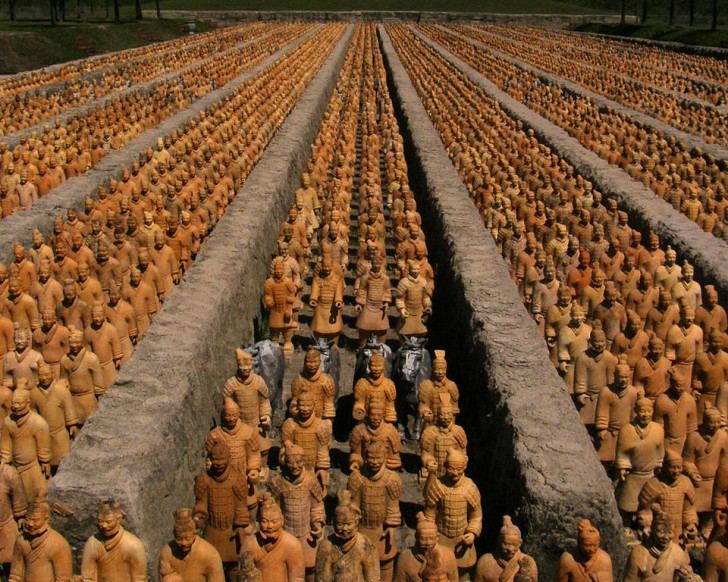
Terracotta Warriors Army
Nearby in other digs were terracotta figures of nonmilitary origins. These included acrobats, musicians, strongmen and other public officials.
There are just three collections that can draw endless crowds globally, for viewing by name recognition alone. These are the artifacts associated with King Tutankhamen, the Titanic and the Terracotta Army.
It is no wonder the ongoing excavations of the mausoleum on Mount Li in Xian, has been established as a World Heritage Site.
Unknown to many tourists, most of the groupings remain buried and are only slowly being unearthed. Painstakingly effort and time as well as money, is required as the project moves forward.
However, the greatest wonders of this site remain elusive and as of yet, unseen for 2200 years.
The greatest archeological discovery of the last century was found in ancient Egypt within the Valley of the Kings. Howard Carter was able to find the tomb of a relatively unknown pharaoh, who was about to become an international sensation.
The unearthing of the final resting place of Tutankhamen soon to be known as King Tut in 1922, was an exciting news event that easily captured the public’s imagination.
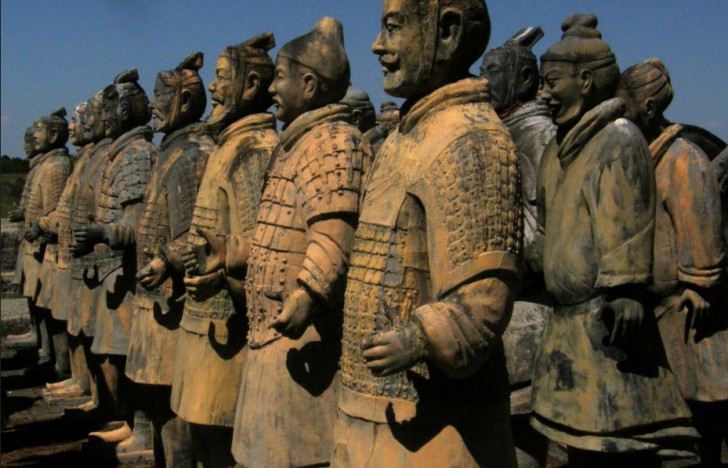
Terracotta Army History
Since the god kings of ancient Egypt were buried with many of their personal possessions, the excavation of the site permitted one be able to take a glimpse of what life was like in 1325 B.C. E. Although the 3,500 artifacts contained in the tomb were numerous and impressive to many, it must be remembered that they are from a reign of just nine years. King Tut came to the throne at the age of nine and died when he was either eighteen or nineteen.
The most awe inspiring revelation of the 21st century in the field of archeology, is most likely already known. It will be the opening of the mausoleum belonging to Qin Shi Huang.
He is also known as the first Emperor of a united China. It will be one of the most incredible media events that the world has ever witnessed.
Our story begins in the spring of 1974, when a number of farmers were digging a water well about a mile from the site of the tomb. The earth being removed contained numerous shards and pieces of pottery, that obviously was part of something more than just a typical antiquated garbage dump.
Chinese archaeologists were soon sent to investigate what until now had simply been rumors and occasional reports, of various findings in the immediate area.
What they found, was going to prove to be one of the most astounding historical discoveries ever. The legend of old, was indeed now found to be based on fact.
The terracotta army was real.
If this part of the literary tale was true, could the rest be as well? It was a spell binding prospect.
What marvelous treasures still remain buried is hard to tell, but we may have clues to what awaits. The construction of the tomb was described by Chinese historian Sima Qian, but since it was written a century after the tomb completion, it was not taken seriously until the unearthing of the terracotta army.
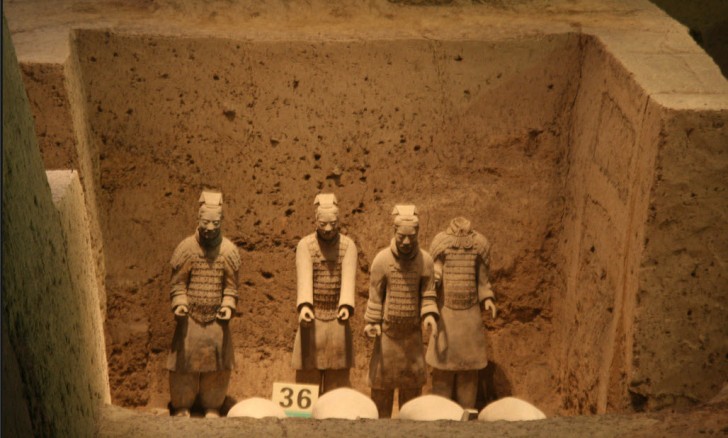
The Terracotta Army
Qian in his most noted work Shiji, describes a project that would eventually involve 700,000 workers and obviously skilled craftsmen. Work on the mausoleum supposedly began in 246 B.C.E., when the Emperor ascended to his first throne at the age of 13.
As he worked to unify China through conquest, work on his final resting place continued for 38 years.
Qian describes how the First Emperor died after a reign of just a decade, over a unified China. He would be buried alongside palaces, towers, valuable artifacts and fabulous works of art.
Contained within is supposedly a miniature replica of ancient China, with numerous minute details and features of the land. According to the account, there were more than 100 simulated flowing rivers, created through the use of mercury. The water was made to move by mechanical means.
In surrounding soils near the terracotta army there have been high levels of mercury discovered, thus giving further credence to the accounts of Sima Qian.
He also describes the ceilings that were fabulously decorated with heavenly bodies. It must be noted that the famed historian himself, makes no mention of the terracotta warriors and horses. Obviously he did not find them worth mentioning, because of the many other unreal creations. Or maybe since he wrote about the site almost a century later, he may have been unaware of their existence. The latter is most likely.
Later accounts of the fate of the mausoleum, suggest it may have been looted by Xiang Yu.
He was a contender for the throne, following the untimely death of the Emperor Qin Shi Huang. It is not really known for sure. It may well have survived intact and appears to be sealed. Whether that was done once or a second time is now blurred.
What is clear was the terracotta warriors themselves were smashed in the chaos, following the death of the Emperor in 210 B.C.E. What tourists see today are figures that have been fastidiously reassembled.
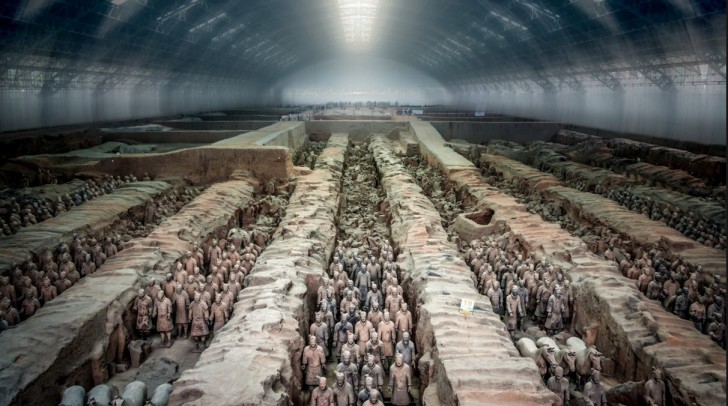
Terracotta Army Facts
The Emperor died at about 50 years of age, after a futile search for an elixir of immortality. The reportedly cause of death, was the ingestion of mercury pills that were ironically supposed to prolong his life.
The first Emperor was credited with unifying China, building an extensive national road system and the First Great Wall of China. Unfortunately, he was also known for the banning and burning of many books, as well as the execution of numerous recalcitrant scholars.
The tomb itself remains unopened for a number of reasons. One is money. It will be very expensive to preserve and document all that may be contained within. There are also concerns about the present techniques in conservation.
It has been well documented that after the excavation of the terracotta army, the figures that were originally painted in vivid colors, began to flake and fade even further just minutes after their unearthing.
Today the main excavation site is contained within a museum complex. It consists of four pits. They are about 0.93 miles or 1.5 kilometers east of the main burial mound. The depth of the digging went down to about 23 feet or the equivalent of 7 meters.
Pit One holds the main army of over 6,000 warriors. It contains 11 corridors which are about 9.8 feet (3 meters) wide. The entire area is 750 feet wide and 203 feet wide.
Pit Two contains cavalry and infantry units as well as war chariots. It is recognized by historians as representing a military guard.
Pit Three seems to be a command post with high ranking officers and a war chariot. Members of the army of higher rank are depicted taller than regular soldiers.
Pit Four was found to be empty.
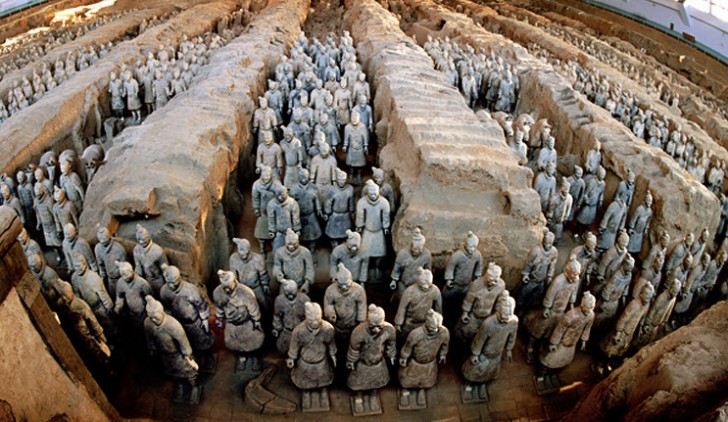
Terracotta Army Location
Originally the members of the Terracotta Army were armed with real weapons.
There is also evidence of fire damage in both Pits One and Two. This may provide additional support for the looting theory. Many of the weapons are missing and the scorching seems to indicate that the roofs of the buildings had been burned. This led to the collapse of the ceilings, which crushed the terracotta warriors and other figures.
Some of the armaments remaining like the swords, were coated with 10-15 micrometers of chromium dioxide. This has kept them rusty free for well over 2,000 years. The metal used contains various alloys created from cobalt, copper, magnesium, nickel and tin. A few actually contain inscriptions that date their creation, showing they were actually used in battle before ending up at the site.
In more recent years, there has been other areas unearthed.
They lie within and without the main tomb walls. Here was found many beautiful artifacts including bronze carriages and additional terracotta creations, from various segments of society. One can also view bronze cranes and ducks in an underground park, along with an assortment of animals also made from terracotta.
At the end of 2012, Chinese officials announced that the remains of a massive imperial palace was located at Mount Li. It encompasses a total 170,000 square meters.
Based on the foundations alone, the area is one quarter the size of the Forbidden City in Beijing.
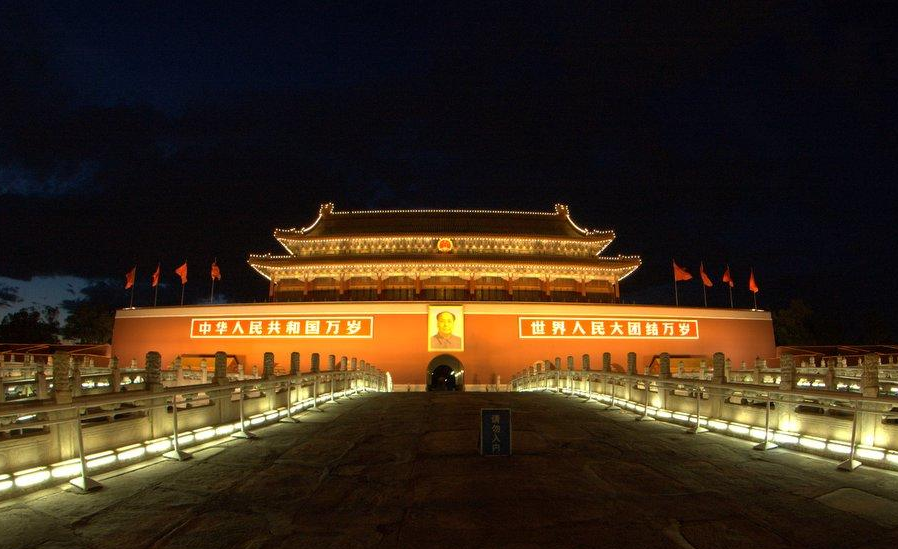
The Forbidden City at night
The palace has been found to contain 18 courtyard houses and a main building overlooking them. Archaeologists have already located roads made from stone, gates, walls, brickwork and an abundance of more pottery shards.
The best and most economical way to visit the Museum of the Terracotta Army and the surrounding area once you arrive in Xian is to take the public bus. There is a special Tourism Bus (5) for this purpose. It has a total of 12 stops to the Warriors and will take about an hour to get there, traversing a total of 26 miles or 42 kilometers.
The first bus departs at 7:00 A.M., and the last one is at 7:00 P.M. Take the exact same bus number on your return.
The cost is just 7 RMB, which is the equivalent of $1.07 USD (United States Dollar)
You can also take the shuttle bus from the Xian Train Station directly to the Terracotta Army. You must present your high speed train from that day and a ticket for the Museum. However, the shuttle pass is only valid for three days.
The first shuttle leaves at 8:00 A.M., and the last one departs at 4:00 P.M. On your return from the Museum, the hours are listed for 10:00 A.M. to 7:00 P.M. The buses leave on an hourly basis.
One can also simply take a taxi, but it will cost more. Expect to pay between 300-400 RMB ($45.98 -$61.31 USD) at current exchange rates. You can try to bargain for a reduced rate, if you would like to engage in a local custom.
The Terracotta Warriors Museum is open 365 days a year. Hours of operation are from 8:30 A.M. to 5:30 P.M.
From March 01 – November 30 the cost of admission to the Museum is RMB 150 ($22.99 USD). The rest of the year the cost is RMB 120 ($18.39 USD).
One can also visit the Mausoleum as part of your admission price, but there is not as much to see as one would expect.
The ticket price provides travelers free luggage storage. Restroom facilities inside the museum are free. Once outside you will need to pay a fee for that service.
Be cautious of local businesses surrounding the Terracotta Warriors Museum. Some of them are unscrupulous when they are dealing with tourists, who are not knowledgeable about local prices and services.
By Jeffrey Hagenmeier

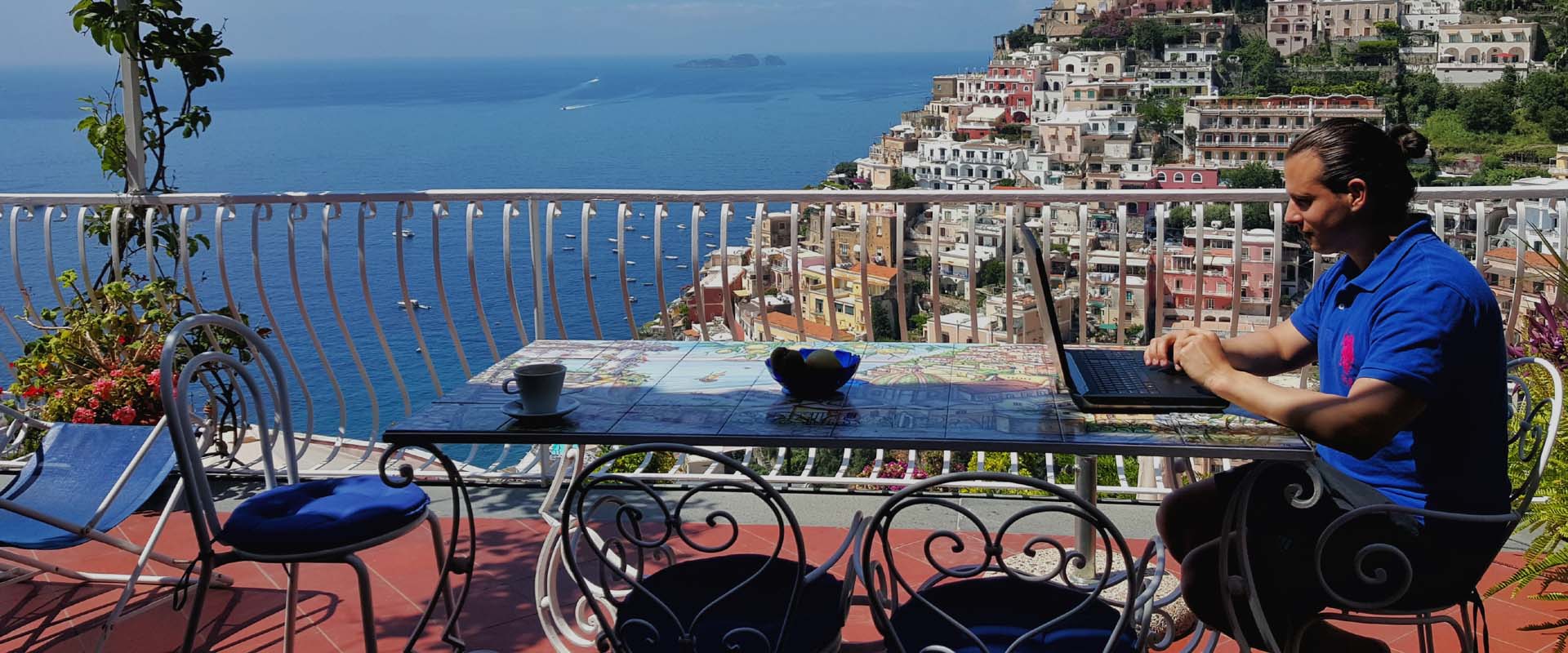
The fact that an emperor would have an entire army made out of terracotta built to protect him in the afterlife is something that never fails to amaze me. When I make it to China, I’ll be certain to visit this wonder of the world.
We can get the historical information to access about history.
It is unbelievable, I always wanted to go there and see inspiring terracotta army!! awesome
It’s crazy how many are there…
AWESOME story—and gripping photos. I cannot express how much I’d love to see these warriors! I’ve seen replicas, but the magnitude of this find–and the sheer age of them would be overwhelming to me (so you could say I am very jealous of you)!
Thank you so much for sharing your awesome travels with us. Amazing!!!
I will be there this summer, and im so excited about it!. Definitively one of the highlights of China.
I love learning something new everyday and this was a beautiful read, i bet it was a majestic sight to witness and i cannot wait to see it for myself someday 🙂
I saw a documentary on Terracotta army recently and it’s truly amazing! Can’t wait to see it with my own eyes!
nice history of Chinese Army, I learn so much about. thank you so much for sharing.
You there, this is really good post here. Thanks for taking the time to post such valuable information. Quality content is what always gets the visitors coming.
thank you for the informative post, will definitely come back for more interesting post.
Interesting articles!! I think it would be helpful for everyone who loves to travel China.
Awesome Article! great written about China. very interesting and informative. Thanks for sharing.